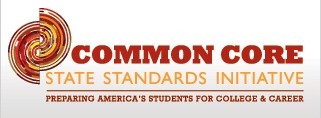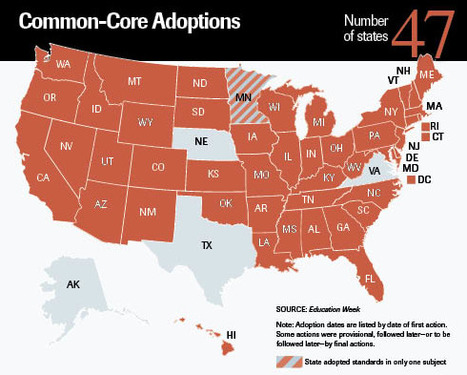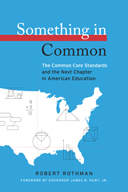 Your new post is loading...
 Your new post is loading...

|
Scooped by
Mel Riddile
|
"Without proper implementation they (Common Core State Standards) will likely have little effect on academic achievement." States must think about changes needed to teacher preparation, professional development for teachers and principals and textbooks and resources that are aligned to the new standards. This is no easy task.

|
Scooped by
Mel Riddile
|
Will the new national standards make our classroom content comparable to the content taught in the best-performing nations? The answer is no. Myth 1: The Common Core standards are high and internationally benchmarked to those of high achieving nations. In other words, will the new national standards make our classroom content comparable to the content taught in the best-performing nations? The answer is no. In this case, the facts show the Common Core standards to be mediocre in rigor and below what high achieving nations expect of their students.

|
Scooped by
Mel Riddile
|
Interactive map links to state CCSS web resources.

|
Scooped by
Mel Riddile
|
The Bottom Line
By the way, one of the most interesting things to discuss with students is the reason, the driving force, behind persuasive writing. What’s the goal here? Is it (a) Getting someone to agree with you, or (b) Persuading someone to take a specific action? What do your students think? What do you think? I would argue that it is both of those–but that neither is the primary purpose behind this complex genre. The real purpose of persuasive writing is to guide the reader through a complex set of issues so that he or she can make a good decision. Lindstrom’s article does that very well, by the way. I will never shop the same way again–and that’s quite an outcome, considering he only had one page to win me over.

|
Scooped by
Mel Riddile
|
The French painter, poet, novelist, director, etc., Jean Cocteau noted the following about our need for myths: Man seeks to escape himself in myth, and does so by any means at his disposal. Drugs, alcohol, or lies.

|
Scooped by
Mel Riddile
|
I spoke with an educator a couple of weeks ago about the new Common Core State Standards (CCSS). He pointed out this was the solution to increasing ri... Rigor is more than what you teach and what standards you cover; it's how you teach and how students show you they understand. True rigor is creating an environment in which each student is expected to learn at high levels, each student is supported so he or she can learn at high levels, and each student demonstrates learning at high levels (Blackburn, 2008). Notice the key aspects of that definition. 1. Create an environment that is conducive to growth. Rigor is about achieving at a higher level, but that doesn't happen immediately. Focus on progress, on the small steps that gradually show student growth. Encouraging students not to give up, using language that shows students you know they can learn, and celebrating the positive will help you create an environment to support rigor. 2. Focus on high expectations. The CCSS are reflective of higher expectations, but you have to reinforce that belief. How can we put high expectations into practice? By not allowing the word "can't"—not from students and not from ourselves. By continually reminding students you know they can do it. A friend of mine says that sometimes you have to believe for your students until they believe in themselves. 3. Support students so they can learn at higher levels. This requires scaffolding within a lesson. Focus on prior knowledge, model the thinking process, and provide support for gaps that occur between students' current knowledge and the new standards. Some students will need extra help outside of class. 4. Allow each student to demonstrate learning. Provide a variety of ways students can demonstrate understanding. It's fine to use questions that are similar to the final assessment, but also provide opportunities that play to students' strengths. Allow students to show what they know through technology, drawings, projects, etc. In addition, as you use formative assessments, incorporate strategies that require each student to participate. Using whole group instruction and asking one student to answer does not accomplish this goal. Use think-pair-shares, clickers, dry erase boards (or a whiteboard app for the iPad), or thumbs-up thumbs-down strategies so you can see if each student is understanding each part of the lesson. That may sound daunting, but you are already demonstrating high expectations, providing support for students, and asking them to show you they understand. If you build on those areas, you’ll create a climate that supports rigor. In my next post, we'll look at other activities to help you incorporate rigor into your classroom. Which of those areas do you need to pay attention to today? Share your thoughts below.

|
Scooped by
Mel Riddile
|
The state Department of Education's cost-benefit analysis of the waivers found what State Board member James Aschwanden called "jaw-dropping numbers." The Department put the net price tag to California @ $600 million to implement Common Core - teacher training,237.5 million; - buying textbooks and materials,237.5 million; - adopting English learner standards,118 million;

|
Scooped by
Mel Riddile
|
This site, currently in beta, will offer practitioners a set of tasks for one standard at each grade level K-8. In the future, "the sets of tasks will include elaborated teaching tasks with detailed information about using them for instructional purposes, rubrics, and student work. Such a fully developed set of tasks will be what we call a Complete Illustration of the standard." Right now we are trying to build up our collection of Initial Illustrations of standards, which will have the following characteristics: - A minimum of 4 tasks (although typically 5-6 or more depending on the standard).
- Most will be more like assessment tasks or brief teaching tasks. At least one will be the kernel of an instructional task that can eventually be more fully developed and elaborated with the help of teachers using it in classrooms.
- The tasks in the set will vary in difficulty. Some but not all will be scaffolded.
- A balance in computational/algorithmic and conceptual tasks.
- An appropriate number of contextual problems for the standard.
- Most of the tasks will illuminate the “center of mass” of the standard, and a few will light up the periphery.
- At least one task will bridge in some way to another standard, ideally across domains or grade levels.

|
Scooped by
Mel Riddile
|
District Leaders See Future Changes in How Textbooks are Adopted "A major change is approaching with the adoption and, in the next four years, the implementation of national Common Core academic standards by 40 states, including South Carolina. With 46 states and D.C. adopting the CCSS, textbook producers will adapt. "There's speculation about what the textbook industry will do," Bosket said. "Common sense would dictate that, with 40 states adopting those standards, the publishers likely will move in a similar direction." Eventually, Common Core should save money, Stowe said, as the textbooks should be less expensive and more likely to match up with standards. Less Narrative Text/More Informational Text "The big issue with Common Core is that they will ask us to use more non-fiction reading," Stowe said. "Right now, most are fiction stories. This will be a shift to informational text and a big different in the reading series. We just hope they will be funded." Note to School Leaders: This article makes no mention of the significant increase in "text complexity." Will our textbooks be out of date?

|
Scooped by
Mel Riddile
|
By Robert Rothman Myth #1 The Common Core State Standards are a national curriculum. Myth #2 The Common Core State Standards are an Obama administration initiative. Myth #3 The Common Core standards represent a modest change from current practice.
In preparation for adoption of the Common Core standards, several states conducted analyses that found considerable alignment between them and their current standards. Yet while the content of the two sets of standards is similar, the level of knowledge and skills the Common Core calls for is in many respects quite different from what current standards expect and what schools currently practice. Take English language arts. Perhaps the main idea of the Common Core ELA standards is the notion that students should read increasingly complex texts in order to be prepared for the reading they will do in postsecondary education. Yet research the standards-writers relied upon showed that the complexity of texts assigned in high school has actually declined over time, while the reading requirements of entry-level college courses have increased. The Common Core Standards raise the expectations for text complexity considerably. Myth #4 States cannot implement the Common Core standards in the current budget climate. Myth #5 The Common Core State Standards will transform schools. Yet even the most passionate advocate of standards will acknowledge that standards, by themselves, do not improve education. Standards can do a great deal: they can set clear goals for learning for students and teachers, and establish guidelines for instruction and performance. But to have an effect on the day-to-day interaction between students and teachers, and thus improve learning, states and districts will have to implement the standards. That will require changes in curricula and assessments to align with the standards, professional development to ensure that teachers know what they are expected to teach, and ultimately, changes in teacher education so that all teachers have the capability to teach all students to the standards. The standards are only the first step on the road to higher levels of learning.

|
Scooped by
Mel Riddile
|
Dr. Laura Taylor, Principal of Urbana (IL) High School For the second consecutive year, Urbana's school district is being honored by the College Board's AP Honor Roll, which recognizes gains in how students can access Advanced Placement classes and how well they score on AP tests. 1. Strong Principal Leadership High school Principal Laura Taylor said she's excited because the school has been working to improve its Advance Placement offerings and support for the last several years. 2. From 3 to 15 AP Classes Nine years ago, the school had three of the classes, which allow students to take a test when they complete the class. If they score high enough, most colleges will grant credit hours for the classes. Now, the school has 15 classes and is hoping to add one or two more, Taylor said. 3. More Test Takers Not only is the school offering more Advanced Placement classes, more students are taking the tests and the school has found more ways to support them better. 4. Building a Pipeline of AP Ready Students For example, freshman, sophomores and juniors can take AP prep classes. 5. Extra Tutoring Services All freshman and sophomores have access to certified teachers for 25 minutes a day to get extra help. "We have just raised the bar across the board to provide more support for kids so they can be more successful in rigorous courses," Taylor said. 6. Student Recognition The school has also started recognizing students who are doing well in college prep classes and asking if they'd like to take an Advance Placement class or prep course, she said. 7. Paying for the Exams The school also tries to make sure that a student can take a test, even if he or she can't afford the $87 fee. 8. Show me your numbers! - Urbana has nearly doubled the number of students taking Advanced Placement tests, from 45 to 86 since 2009, according to a release from the district. - The percentage of its students scoring 3 or higher on the test has been consistently higher than the national and global average at least since 2007, according to a chart from Taylor. For example, in 2011, 81 percent of Urbana students scored 3 or higher, compared with 66 percent nationally and 60 percent worldwide. 9. College Credit Taylor said students who score that high can save money because it will earn them college credit. Nine Urbana alums who went to the University of Illinois accumulated 99 credit hours among them, Taylor said. 10. Heightened Expectations/Increased Rigor She said she believes the classes make a difference for everyone at the school. "I think it raises the level of rigor across the building," Taylor said, as the only classes offered are college prep, advanced placement prep classes and the Advanced Placement classes themselves. "I think it just raises the bar for everybody," she said. The Bottom Line Urbana High School has a thriving AP because of the persistent and focused leadership provided by Dr. Larua Taylor. Congratulations!

|
Scooped by
Mel Riddile
|
As Unlock the Teacher works with a few schools this year in aligning their building curriculum to the Common Core State Standards Model (CCSS) for ELA and Math, we are having some great discussions.

|
Scooped by
Mel Riddile
|
Willowbrook High earns national accolades for its academics, yet fewer than half of the west suburban school's students who took state standardized tests this spring scored at grade level in reading, math and science. Months after Illinois officials closed a loophole used to keep academically weak 11th-graders from taking state exams, high school scores plummeted to the lowest level in a decade, and educators from Addison to Zion are grappling with the fallout. More than half of the state's 666 public high schools saw their test scores slump as fewer students passed state exams in reading, math and science. The Illinois State Board of Education now mandates that 11th-graders take the state exam before they can advance to the senior class. What's more, their scores must count toward a school's overall performance under the federal No Child Left Behind law. The change spurred high schools statewide to test all 11th-graders and any 12th-graders who previously had skipped the exams, boosting the number of test-takers statewide by nearly 12,000 students this spring. Still, the dramatic year-to-year shifts can be difficult to explain to parents. Note: While all students must take the test before advancing to the 12th grade, their scores do not impact them individually. The scores only affect teachers, principals and schools.
|

|
Scooped by
Mel Riddile
|
"Many things that are commonplace activities for adults — driving, voting, and paying taxes, for example — are not appropriate for children. I count the Common Core State Standards, proposed for all our country’s public schools, among them. Over my more than 50 years in public education I’ve come to know young children pretty well, and I am sure that 8-9 years olds are not ready to “describe the relationship between a series of historical events, scientific ideas or concepts, or steps in technical procedures in a text, using language that pertains to time, sequence, and cause/effect,” as decreed by one of the standards for third-grade readers of informational text."

|
Scooped by
Mel Riddile
|
The three-year transition to a more challenging K-12 curriculum in math and English language arts has just begun, but some school officials worry the state isn't moving fast enough. The Common Core Standards will: 1. be more rigorous 2. demand higher-order thinking 3. introduce some concepts at an earlier age. 4. Allow for interstate comparisons. - "South Dakota will get its best look yet at how its students stack up against much of the rest of the country." "An investment we can't affort not to fund." - Harrisburg Superintendent Jim Holbeck said teachers will need a lot of time to align their lessons to Common Core. That’s going to require professional development during the summer, he said, and teachers will have to be paid for that time. “This is an investment we can’t afford not to fund,” he said. But for now, school districts are planning to bear much of the costs on their own. Transition creates gaps in instruction
- The tricky thing about moving to Common Core will be the transition years.
- When the new standards are implemented and a key math concept moves from second grade to first grade, what happens to that year’s second-graders? - "Gap Map" - In Sioux Falls, committees of educators are assembling a “gap map,” which will identify the lessons students will miss if nothing is done. Next, they’ll create mini-units for the affected teachers to use during the transition. Testing Challenges Testing students during the transition presents its own challenges. South Dakota is part of a 30-state consortium developing new assessments they hope will be ready for 2015. In the interim, students will continue to take the Dakota-STEP. That means that until at least 2014, students will be tested and schools held accountable based on the state’s old math standards. But many school districts will have the new standards in place well before then. The state will embed the Dakota-STEP with 20 questions from Common Core, but those questions will not count for school accountability. “Even though Dakota-STEP will continue to be administered right up until 2015, teachers will be teaching the new K-12 Common Core state math standards starting next year in 2012,” McAdaragh said.

|
Scooped by
Mel Riddile
|
"With change often comes trepidation and there seems to be plenty of that in regards to implementation of the Common Core State Standards. Within the last week, I’ve linked to an article claiming the standards aren’t rigorous enough, another in which officials were worried they would prove to be too tough (a more common theme), as well as one filled with concern about online assessments. As you probably know, the conversation doesn’t end there."

|
Scooped by
Mel Riddile
|
Myth 3: The Common Core standards do not dictate the curriculum. States are free to define their own curricula based on the Common Core. While it is technically true that the national standards don’t dictate curriculum by themselves, they are the foundation for national tests already being prepared by federally-funded assessment consortia—and, once institutionalized, the national tests will necessarily force the creation of a national curriculum. "One impact I am sure of: Governance of our schools will shift to Washington. And it won’t come back any time soon. Mr. Duncan’s office will function much more as European Ministries of Education. Perhaps it will be like the French system of which the late President Mitterand once boasted that at any minute during the day he knew precisely what French students, whether in Paris or some rural hamlet in Brittany, were learning."

|
Scooped by
Mel Riddile
|
The Howard County (MD) school system is considering major changes to its middle school class schedule that include discontinuing reading as a stand-alone subject for most students, school officials said. In addition, the school day might be reduced from eight instruction periods to seven 50-minute periods, with physical education classes held every other day. In Howard County, reading would be a part of all middle-school subjects, and students who are performing below grade level would receive additional support that could include a stand-alone reading course, school officials said. "I believe that in the 1990s, the decision was made for Howard County middle schools to have a separate reading class," Wise added. "That has served us very well in the past. But now, with the common core and the emphasis on college and career readiness, we want to move further to make sure that our students have the critical thinking skills and that they are able to read and comprehend and write like a historian or a scientist or a musician within those specific content fields."

|
Scooped by
Mel Riddile
|
"In a meeting with parents Monday at Perez Elementary School on the city's West Side, Mayor Rahm Emanuel and Chicago Public Schools chief Jean-Claude Brizard saw how even the best CPS schools will struggle to measure up when the district adopts a more rigorous curriculum (Common Core State Standards) next school year." School was commended for performance has one one-quarter at or above grade level in reading. - This year, Perez, a predominantly Hispanic school in the Pilsen neighborhood, is among the first CPS schools to implement the tougher Common Core curriculum, a national initiative to improve student comprehension and analysis in core subjects such as math and reading. The early returns aren't good. Perez's performance on the Illinois Standard Achievement Test and other benchmarks last year earned an elite Level 1 ranking from CPS. But barely one-third of third-, fourth- and fifth-graders at Perez scored at or above their grade levels in reading and slightly more than one-third did so in math on testing aligned with Common Core. Little more than one-quarter of Perez's sixth- and eighth-graders were at or above their grade level in reading. "At first it's a shock, it's a shock to anyone who sees it," said Perez Principal Vicky Kleros. "It's really a sobering score card."

|
Scooped by
Mel Riddile
|
The Partnership for Assessment of Readiness for College and Careers, or PARCC, has released its final content frameworks for the common standards. And the newsiest thing about the document is this: The consortium is going to create content frameworks for grades K-2. - the frameworks are an attempt to capture the key ideas in the common standards to guide curriculum developers, teachers, and test developers. - The "content specifications" issued by the other assessment group, the SMARTER Balanced Assessment Consortium, or SBAC... are a bit different from PARCC's content frameworks - both documents begin to put some meat on the bones of the two groups' visions of the tests they are working on. More Guidance for Math - PARCC also attempts to offer more specifics to guide creation of math courses at the high school level, an area it admits has been "challenging." They don't come right out and say it here, but one of the challenges is political: taking steps toward more specificity while steering clear of dictating curriculum. Literacy Grade 12 - On the literacy side of the house, PARCC said it got a lot of requests for content frameworks for grade 12. It won't do that, but it will—as it has said all along—create "bridge courses" that will beef up seniors' readiness for college. - balancing areas of emphasis and being clear about intent. - Clarify emphasis on "close reading" of text and the importance of students being able to move between multiple texts and across disciplines. My note: According to PARCC's published timeline, they are right on schedule.

|
Scooped by
Mel Riddile
|
Due to a comment by a follower, I changed the title of this scoopit. "While the article is accurate, the title is misleading. In fact, David Coleman, one of the key authors of the standards, has repeatedly stressed that argumentative writing replaces persuasive writing. A more appropriate title would be: Shift to ARGUMENTATIVE Writing is a Key Focus in the Common Core." "This is not merely a matter of semantics. I am doing extensive work with schools to prepare teachers to understand the fundamental shifts, and most are highly surprised at this particular shift. Given that many will glance over the title and run with the information, this error is egregious and holds potential to gravely mislead." --- Across the Curriculum
"If you look through the Common Core Standards, you'll see words peppered all over the place that point to persuasive writing: interpret, argument, analyze. The focus isn't to provide evidence as the sole means to prove, but rather to make an argument and bring in evidence that one must then justify through argumentation.
For instance, rather than merely solving a math problem, the equation serving as the answer in itself, and moving on to the next question, there is a possibility that persuasive writing will come into play that has the student selecting what formula to use, making an argument, and using the computations as evidence to back up that argument. In my department, English Language Arts, we are already spinning Literary Analysis into a literary persuasive composition in order to address the future of this more meaningful writing. Rather than teach two compartmentalized writing genres, doesn't it make more sense to blend the two and have the student convince the reader of the theme or the character change or the author's intent? It comes at analysis from a different, more authentic angle."

|
Scooped by
Mel Riddile
|
Is this a harbinger of things to come? Will the implementation of the Common Core State Standards result in even lower pass rates? "A look at old test results is providing a troubling glimpse into just how poorly Michigan students have done on state exams." "Just about a quarter of students in grades 8 and 11 would have passed." "The Michigan Department of Education released the last four year's worth of results from the high school Michigan Merit Exam and the elementary and middle school Michigan Educational Assessment Program exam, but with a twist.
They applied tough new standards for passing the exams—standards that were adopted by the State Board of Education in September—to the old results. Under the new system, students must answer substantially more questions correct in order to pass."

|
Scooped by
Mel Riddile
|
With Montana's move today, that's down to four states, as you can see from our updated map: Alaska, Nebraska, Texas, and Virginia.

|
Scooped by
Mel Riddile
|
NYS State Education Commissioner John King and David Coleman, contributing author to the CCSS discuss the standards and implementation...

|
Scooped by
Mel Riddile
|
Watch this video presentation here: http://neric.welearntube.org/?q=node/146 Shifts in literacy with CC 1. 50 percent stories and 50 percent informational text. We know in K-5 that is where the foundation of knowledge is developed. Great place to learn about the world and create mental structures for future learning. 2. The building of knowledge rest in science and technical subjects art, history, technology, engineering. The ELA Common Core includes those content area. Those subjects demand that literacy drives learning in those areas. Reading, writing, and thinking. Literacy plays a major role in gaining knowledge in those subjects. 3. Text complexity matters. The difficulty and complexity of the text plays a major role in guiding literacy performance rather than the skills by which you are reading it. First time there is step in complexity of text as student increase in grade level. 4. Focusing on questions that require you to pay attention to the text itself. 5. Writing- Shift to getting student to write persuasive arguments with researched supporting evidence. 6. Academic vocabulary is the true language of power. True for language learners. Summation: Read like a detective and write like a conscientious investigative reporter
|
 Your new post is loading...
Your new post is loading...
 Your new post is loading...
Your new post is loading...

























